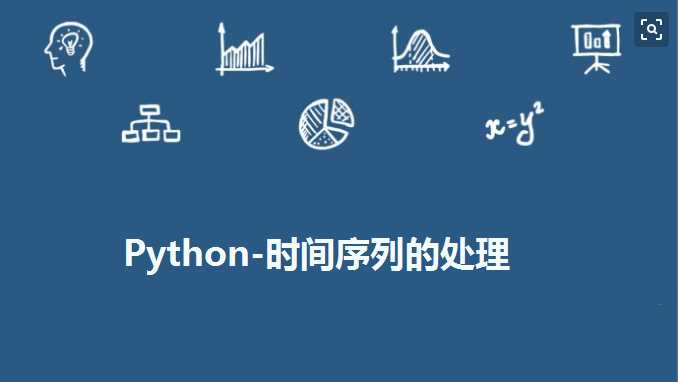Python学习教程(Python学习路线):Pandas库基础分析-详解时间序列的处理
Posted cherry-tang
tags:
篇首语:本文由小常识网(cha138.com)小编为大家整理,主要介绍了Python学习教程(Python学习路线):Pandas库基础分析-详解时间序列的处理相关的知识,希望对你有一定的参考价值。
Python学习教程(Python学习路线):Pandas库基础分析-详解时间序列的处理

在使用Python进行数据分析时,经常会遇到时间日期格式处理和转换,特别是分析和挖掘与时间相关的数据,比如量化交易就是从历史数据中寻找股价的变化规律。Python中自带的处理时间的模块有datetime,NumPy库也提供了相应的方法,Pandas作为Python环境下的数据分析库,更是提供了强大的日期数据处理的功能,是处理时间序列的利器。
1、生成日期序列
主要提供pd.data_range()和pd.period_range()两个方法,给定参数有起始时间、结束时间、生成时期的数目及时间频率(freq=‘M’月,‘D’天,‘W’,周,‘Y’年)等。
两种主要区别在于pd.date_range()生成的是DatetimeIndex格式的日期序列;pd.period_range()生成的是PeriodIndex格式的日期序列。
以下通过生成月时间序列和周时间序列来对比下:
date_rng = pd.date_range(‘2019-01-01‘, freq=‘M‘, periods=12)
print(f‘month date_range(): date_rng‘)
"""
date_range():
DatetimeIndex([‘2019-01-31‘, ‘2019-02-28‘, ‘2019-03-31‘, ‘2019-04-30‘,
‘2019-05-31‘, ‘2019-06-30‘, ‘2019-07-31‘, ‘2019-08-31‘,
‘2019-09-30‘, ‘2019-10-31‘, ‘2019-11-30‘, ‘2019-12-31‘],
dtype=‘datetime64[ns]‘, freq=‘M‘)
"""
period_rng = pd.period_range(‘2019/01/01‘, freq=‘M‘, periods=12)
print(f‘month period_range(): period_rng‘)
"""
period_range():
PeriodIndex([‘2019-01‘, ‘2019-02‘, ‘2019-03‘, ‘2019-04‘, ‘2019-05‘, ‘2019-06‘,
‘2019-07‘, ‘2019-08‘, ‘2019-09‘, ‘2019-10‘, ‘2019-11‘, ‘2019-12‘],
dtype=‘period[M]‘, freq=‘M‘)
"""
date_rng = pd.date_range(‘2019-01-01‘, freq=‘W-SUN‘, periods=12)
print(f‘week date_range(): date_rng‘)
"""
week date_range():
DatetimeIndex([‘2019-01-06‘, ‘2019-01-13‘, ‘2019-01-20‘, ‘2019-01-27‘,
‘2019-02-03‘, ‘2019-02-10‘, ‘2019-02-17‘, ‘2019-02-24‘,
‘2019-03-03‘, ‘2019-03-10‘, ‘2019-03-17‘, ‘2019-03-24‘],
dtype=‘datetime64[ns]‘, freq=‘W-SUN‘)
"""
period_rng=pd.period_range(‘2019-01-01‘,freq=‘W-SUN‘,periods=12)
print(f‘week period_range(): period_rng‘)
"""
week period_range():
PeriodIndex([‘2018-12-31/2019-01-06‘, ‘2019-01-07/2019-01-13‘,
‘2019-01-14/2019-01-20‘, ‘2019-01-21/2019-01-27‘,
‘2019-01-28/2019-02-03‘, ‘2019-02-04/2019-02-10‘,
‘2019-02-11/2019-02-17‘, ‘2019-02-18/2019-02-24‘,
‘2019-02-25/2019-03-03‘, ‘2019-03-04/2019-03-10‘,
‘2019-03-11/2019-03-17‘, ‘2019-03-18/2019-03-24‘],
dtype=‘period[W-SUN]‘, freq=‘W-SUN‘)
"""
date_rng = pd.date_range(‘2019-01-01 00:00:00‘, freq=‘H‘, periods=12)
print(f‘hour date_range(): date_rng‘)
"""
hour date_range():
DatetimeIndex([‘2019-01-01 00:00:00‘, ‘2019-01-01 01:00:00‘,
‘2019-01-01 02:00:00‘, ‘2019-01-01 03:00:00‘,
‘2019-01-01 04:00:00‘, ‘2019-01-01 05:00:00‘,
‘2019-01-01 06:00:00‘, ‘2019-01-01 07:00:00‘,
‘2019-01-01 08:00:00‘, ‘2019-01-01 09:00:00‘,
‘2019-01-01 10:00:00‘, ‘2019-01-01 11:00:00‘],
dtype=‘datetime64[ns]‘, freq=‘H‘)
"""
period_rng=pd.period_range(‘2019-01-01 00:00:00‘,freq=‘H‘,periods=12)
print(f‘hour period_range(): period_rng‘)
"""
hour period_range():
PeriodIndex([‘2019-01-01 00:00‘, ‘2019-01-01 01:00‘, ‘2019-01-01 02:00‘,
‘2019-01-01 03:00‘, ‘2019-01-01 04:00‘, ‘2019-01-01 05:00‘,
‘2019-01-01 06:00‘, ‘2019-01-01 07:00‘, ‘2019-01-01 08:00‘,
‘2019-01-01 09:00‘, ‘2019-01-01 10:00‘, ‘2019-01-01 11:00‘],
dtype=‘period[H]‘, freq=‘H‘)
"""
2、生成Timestamp对象及转换
创建一个Timestamp时间戳对象有pd.Timestamp()方法和pd.to_datetime()方法。如下所示:
ts=pd.Timestamp(2019,1,1)
print(f‘pd.Timestamp()-1:ts‘)
#pd.Timestamp()-1:2019-01-01 00:00:00
ts=pd.Timestamp(dt(2019,1,1,hour=0,minute=1,second=1))
print(f‘pd.Timestamp()-2:ts‘)
#pd.Timestamp()-2:2019-01-01 00:01:01
ts=pd.Timestamp("2019-1-1 0:1:1")
print(f‘pd.Timestamp()-3:ts‘)
#pd.Timestamp()-3:2019-01-01 00:01:01
print(f‘pd.Timestamp()-type:type(ts)‘)
#pd.Timestamp()-type:<class ‘pandas._libs.tslibs.timestamps.Timestamp‘>
#dt=pd.to_datetime(2019,1,1) 不支持
dt=pd.to_datetime(dt(2019,1,1,hour=0,minute=1,second=1))
print(f‘pd.to_datetime()-1:dt‘)
#pd.to_datetime()-1:2019-01-01 00:01:01
dt=pd.to_datetime("2019-1-1 0:1:1")
print(f‘pd.to_datetime()-2:dt‘)
#pd.to_datetime()-2:2019-01-01 00:01:01
print(f‘pd.to_datetime()-type:type(dt)‘)
#pd.to_datetime()-type:<class ‘pandas._libs.tslibs.timestamps.Timestamp‘>
#pd.to_datetime生成自定义时间序列
dtlist=pd.to_datetime(["2019-1-1 0:1:1", "2019-3-1 0:1:1"])
print(f‘pd.to_datetime()-list:dtlist‘)
#pd.to_datetime()-list:DatetimeIndex([‘2019-01-01 00:01:01‘, ‘2019-03-01 00:01:01‘], dtype=‘datetime64[ns]‘, freq=None)
#时间戳转换为period月时期
pr = ts.to_period(‘M‘)
print(f‘ts.to_period():pr‘)
#ts.to_period():2019-01
print(f‘pd.to_period()-type:type(pr)‘)
#pd.to_period()-type:<class ‘pandas._libs.tslibs.period.Period‘>
3、生成period对象及转换
#定义时期period
per=pd.Period(‘2019‘)
print(f‘pd.Period():per‘)
#pd.Period():2019
per_del=pd.Period(‘2019‘)-pd.Period(‘2018‘)
print(f‘2019和2018间隔per_del年‘)#可以直接+、-整数(代表年)
#2019和2018间隔1年
#时期转换为时间戳
print(per.to_timestamp(how=‘end‘))#2019-12-31 00:00:00
print(per.to_timestamp(how=‘start‘))#2019-01-01 00:00:00
4、生成时间间隔Timedelta
#生成时间间隔Timedelta
print(pd.Timedelta(days=5, minutes=50, seconds=20, milliseconds=10, microseconds=10, nanoseconds=10))
#5 days 00:50:20.010010
#获取当前时间
now=pd.datetime.now()
#计算当前时间往后50天的日期
dt=now+pd.Timedelta(days=50)
print(f‘当前时间是now, 50天后时间是dt‘)
#当前时间是2019-06-08 17:59:31.726065, 50天后时间是2019-07-28 17:59:31.726065
#只显示年月日
print(dt.strftime(‘%Y-%m-%d‘))#2019-07-28
5、重采样及频率转换
#asfreq 按季度显示索引值
#‘DatetimeIndex‘ object has no attribute ‘asfreq‘
date=pd.date_range(‘1/1/2018‘, periods=20, freq=‘D‘)
tsdat_series=pd.Series(range(20),index=date)
tsp_series=tsdat_series.to_period(‘D‘)
print(tsp_series.index.asfreq(‘Q‘))
date=pd.period_range(‘1/1/2018‘, periods=20, freq=‘D‘)
tsper_series=pd.Series(range(20),index=date)
print(tsper_series.index.asfreq(‘Q‘))
"""
PeriodIndex([‘2018Q1‘, ‘2018Q1‘, ‘2018Q1‘, ‘2018Q1‘, ‘2018Q1‘, ‘2018Q1‘,
‘2018Q1‘, ‘2018Q1‘, ‘2018Q1‘, ‘2018Q1‘, ‘2018Q1‘, ‘2018Q1‘,
‘2018Q1‘, ‘2018Q1‘, ‘2018Q1‘, ‘2018Q1‘, ‘2018Q1‘, ‘2018Q1‘,
‘2018Q1‘, ‘2018Q1‘],
dtype=‘period[Q-DEC]‘, freq=‘Q-DEC‘)
"""
#resample 按季度统计并显示
print(tsdat_series.resample(‘Q‘).sum().to_period(‘Q‘))
"""
2018Q1 190
Freq: Q-DEC, dtype: int64
"""
#groupby 按周进行汇总求平均值
print(tsdat_series.groupby(lambda x:x.weekday).mean())
"""
0 7.0
1 8.0
2 9.0
3 10.0
4 11.0
5 12.0
6 9.5
dtype: float64
"""
之前也跟大家有讲过pandas的相关教程,大家有不理解的地方可回过头复习一下,更多的Python学习教程和Python学习路线会继续跟大家分享!
以上是关于Python学习教程(Python学习路线):Pandas库基础分析-详解时间序列的处理的主要内容,如果未能解决你的问题,请参考以下文章